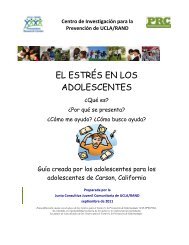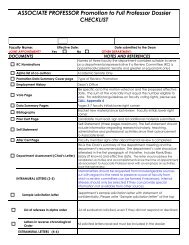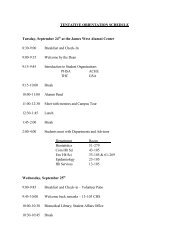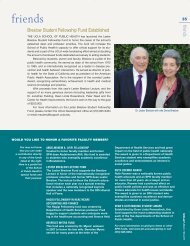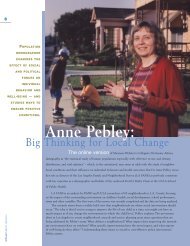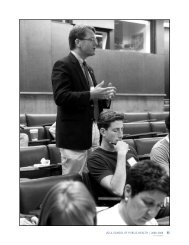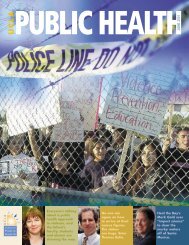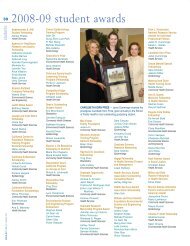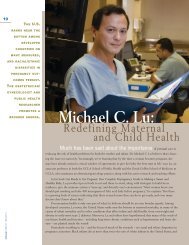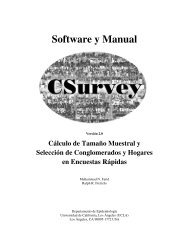A BROADER VIEWOF HEALTH: - UCLA School of Public Health
A BROADER VIEWOF HEALTH: - UCLA School of Public Health
A BROADER VIEWOF HEALTH: - UCLA School of Public Health
Create successful ePaper yourself
Turn your PDF publications into a flip-book with our unique Google optimized e-Paper software.
Ironically, Rimoin’s group noted, one <strong>of</strong> public<br />
health’s greatest success stories opened the door for<br />
the dramatic increase. The eradication <strong>of</strong> smallpox,<br />
announced in 1980, spelled the end <strong>of</strong> a vaccination<br />
program that had also provided protective immunity<br />
against monkeypox, a related virus believed to be<br />
carried primarily by squirrels and other rodents.<br />
(Although generally less lethal than smallpox,<br />
monkeypox can cause serious symptoms, including<br />
severe eruptions on the skin, fever, headaches,<br />
swollen lymph nodes and, in some cases, blindness<br />
and death.) Particularly in rural areas, where displaced<br />
populations rely to a greater extent on bushmeat, the<br />
growing number <strong>of</strong> unvaccinated individuals over<br />
time led to a gradual increase in the rate <strong>of</strong> infection.<br />
But in the absence <strong>of</strong> any surveillance, Rimoin notes,<br />
monkeypox “fell under the radar.” (For more on the<br />
study, see page 23.)<br />
Growing up in Los Angeles, Rimoin always had<br />
positive associations with Africa. In a home adorned<br />
with African art, her father would recall fondly his<br />
research experiences working with a Pygmy population<br />
in the Central African Republic. At Middlebury<br />
College in Vermont, Rimoin earned her undergraduate<br />
degree in African History. It was only after graduating<br />
and going into the Peace Corps that she became<br />
interested in science, and particularly epidemiology.<br />
In Benin, West Africa, Rimoin spent two years as a<br />
volunteer coordinator for the guinea worm eradication<br />
effort. “It was a perfect public health program<br />
that taught me to do disease surveillance,” she says.<br />
“It really brought home the importance <strong>of</strong> using<br />
basic epidemiologic methods to solve a problem.”<br />
Upon completing the program, Rimoin enrolled<br />
at the <strong>UCLA</strong> <strong>School</strong> <strong>of</strong> <strong>Public</strong> <strong>Health</strong>, where she<br />
received her M.P.H. in 1996. For her internship<br />
she worked in Nepal doing disease surveillance for<br />
the World <strong>Health</strong> Organization’s polio eradication<br />
program. Rimoin was then hired by the WHO as a<br />
logistics <strong>of</strong>ficer, assisting in the expanded polio surveillance<br />
and eradication program in Ethiopia and<br />
Eretria. She also initiated a collaborative relationship<br />
between the WHO and the Peace Corps, including<br />
development <strong>of</strong> a program and training materials for<br />
health-oriented Peace Corps volunteers to carry out<br />
disease surveillance activities in Africa and Nepal.<br />
After completing her Ph.D. at the Johns Hopkins<br />
Bloomberg <strong>School</strong> <strong>of</strong> <strong>Public</strong> <strong>Health</strong> in 2003, Rimoin<br />
worked as a program scientist for the National<br />
Institute <strong>of</strong> Child <strong>Health</strong> and Human Development,<br />
coordinating clinical studies in Africa. While at a<br />
meeting at the DRC Ministry <strong>of</strong> <strong>Health</strong>, she was<br />
part <strong>of</strong> a discussion in which it was noted that there<br />
had been an increase in reported cases <strong>of</strong> human<br />
monkeypox in the country. Rimoin’s interest was<br />
piqued. “It made sense to me that given the lack<br />
<strong>of</strong> infrastructure and absence <strong>of</strong> disease surveillance,<br />
if there were any significant reports <strong>of</strong> monkeypox<br />
out there it was likely a much bigger problem than<br />
anyone was anticipating,” she says. Rimoin promptly<br />
proposed to head the first epidemiologic study<br />
assessing the burden <strong>of</strong> human monkeypox in<br />
DRC, and received funding to begin setting up<br />
her program in 2004.<br />
Ever since, Rimoin and her team have been training<br />
local health workers in identifying and reporting<br />
cases as well as interviewing monkeypox patients to<br />
learn about their potential exposures. The workers<br />
collect biological samples that are transported to the<br />
project’s field station and then to Kinshasa, as well<br />
as to collaborators in the United States who conduct<br />
laboratory analyses and report back to the Congolese<br />
field workers.<br />
One reason the DRC was in such dire need<br />
<strong>of</strong> a disease surveillance program is that there are<br />
tremendous logistical challenges to implementing<br />
one. From the beginning, Rimoin’s team has faced<br />
problems such as how to collect and preserve biological<br />
specimens in settings that <strong>of</strong>ten lacked electricity,<br />
running water and refrigeration sources. A<br />
country <strong>of</strong> 900,000 square kilometers has only about<br />
300 kilometers worth <strong>of</strong> roads. Given the expense<br />
<strong>of</strong> gasoline and the DRC’s scarce economic resources,<br />
cost is never far from Rimoin’s mind. “Our supervisors<br />
have motorcycles, but for day-to-day surveillance<br />
we give our health care workers bicycles so they can<br />
take supplies from the headquarters to their village,”<br />
she says. “That can be as many as 200-300 kilometers<br />
away, but it’s a sustainable approach.”<br />
At the <strong>UCLA</strong> <strong>School</strong> <strong>of</strong> <strong>Public</strong> <strong>Health</strong>, where<br />
she has been a member <strong>of</strong> the faculty since 2004,<br />
Rimoin teaches her students the importance <strong>of</strong><br />
working with local collaborators, understanding the<br />
socio-cultural and political context in which problems<br />
occur, and designing and implementing interventions<br />
that are practical and feasible, particularly in lowresource<br />
settings. “Emerging infectious diseases are<br />
definitely out there,” she says. “You just need to<br />
identify the populations at the highest risk and<br />
make sure you’re asking the right questions or you’re<br />
going to miss important events that signal the early<br />
emergence <strong>of</strong> a disease.”<br />
Rimoin, who spends roughly a third <strong>of</strong> her time<br />
working in the field in the DRC, is committed to<br />
being there for the long haul. “My goal is sustainable<br />
research,” she says. “I am fully invested in my work<br />
in the DRC and intend to have a long relationship<br />
with my Congolese collaborators.”<br />
“It made<br />
sense to me<br />
that given<br />
the lack <strong>of</strong><br />
infrastructure<br />
and absence<br />
<strong>of</strong> disease<br />
surveillance,<br />
if there were<br />
any significant<br />
reports <strong>of</strong><br />
monkeypox<br />
out there it<br />
was likely a<br />
much bigger<br />
problem than<br />
anyone was<br />
anticipating.”<br />
—Dr. Anne Rimoin<br />
9<br />
faculty pr<strong>of</strong>ile <strong>UCLA</strong>PUBLIC <strong>HEALTH</strong>




